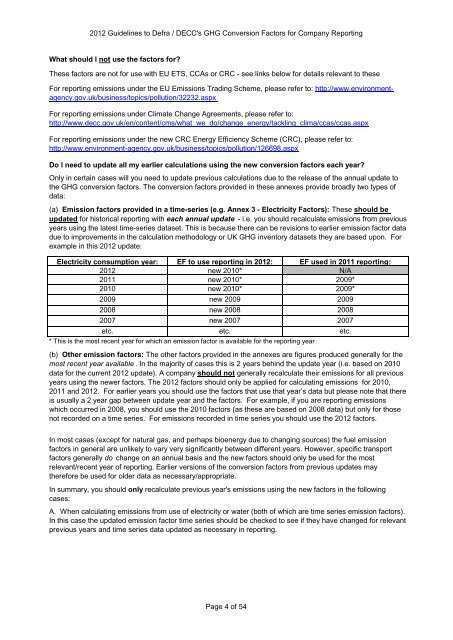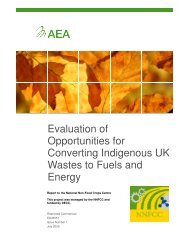Greenhouse gas conversion factors for company reporting
Greenhouse gas conversion factors for company reporting
Greenhouse gas conversion factors for company reporting
Create successful ePaper yourself
Turn your PDF publications into a flip-book with our unique Google optimized e-Paper software.
2012 Guidelines to Defra / DECC's GHG Conversion Factors <strong>for</strong> Company Reporting<br />
What should I not use the <strong>factors</strong> <strong>for</strong>?<br />
These <strong>factors</strong> are not <strong>for</strong> use with EU ETS, CCAs or CRC - see links below <strong>for</strong> details relevant to these<br />
schemes.<br />
For <strong>reporting</strong> emissions under the EU Emissions Trading Scheme, please refer to: http://www.environmentagency.gov.uk/business/topics/pollution/32232.aspx<br />
For <strong>reporting</strong> emissions under Climate Change Agreements, please refer to:<br />
http://www.decc.gov.uk/en/content/cms/what_we_do/change_energy/tackling_clima/ccas/ccas.aspx<br />
For <strong>reporting</strong> emissions under the new CRC Energy Efficiency Scheme (CRC), please refer to:<br />
http://www.environment-agency.gov.uk/business/topics/pollution/126698.aspx<br />
Do I need to update all my earlier calculations using the new <strong>conversion</strong> <strong>factors</strong> each year?<br />
Only in certain cases will you need to update previous calculations due to the release of the annual update to<br />
the GHG <strong>conversion</strong> <strong>factors</strong>. The <strong>conversion</strong> <strong>factors</strong> provided in these annexes provide broadly two types of<br />
data:<br />
(a) Emission <strong>factors</strong> provided in a time-series (e.g. Annex 3 - Electricity Factors): These should be<br />
updated <strong>for</strong> historical <strong>reporting</strong> with each annual update - i.e. you should recalculate emissions from previous<br />
years using the latest time-series dataset. This is because there can be revisions to earlier emission factor data<br />
due to improvements in the calculation methodology or UK GHG inventory datasets they are based upon. For<br />
example in this 2012 update:<br />
Electricity consumption year:<br />
2012<br />
2011<br />
EF to use <strong>reporting</strong> in 2012:<br />
new 2010*<br />
new 2010*<br />
EF used in 2011 <strong>reporting</strong>:<br />
N/A<br />
2009*<br />
2010 new 2010* 2009*<br />
2009 new 2009 2009<br />
2008 new 2008 2008<br />
2007<br />
new 2007<br />
2007<br />
etc. etc. etc.<br />
* This is the most recent year <strong>for</strong> which an emission factor is available <strong>for</strong> the <strong>reporting</strong> year<br />
(b) Other emission <strong>factors</strong>: The other <strong>factors</strong> provided in the annexes are figures produced generally <strong>for</strong> the<br />
most recent year available . In the majority of cases this is 2 years behind the update year (i.e. based on 2010<br />
data <strong>for</strong> the current 2012 update). A <strong>company</strong> should not generally recalculate their emissions <strong>for</strong> all previous<br />
years using the newer <strong>factors</strong>. The 2012 <strong>factors</strong> should only be applied <strong>for</strong> calculating emissions <strong>for</strong> 2010,<br />
2011 and 2012. For earlier years you should use the <strong>factors</strong> that use that year’s data but please note that there<br />
is usually a 2 year gap between update year and the <strong>factors</strong>. For example, if you are <strong>reporting</strong> emissions<br />
which occurred in 2008, you should use the 2010 <strong>factors</strong> (as these are based on 2008 data) but only <strong>for</strong> those<br />
not recorded on a time series. For emissions recorded in time series you should use the 2012 <strong>factors</strong>.<br />
In most cases (except <strong>for</strong> natural <strong>gas</strong>, and perhaps bioenergy due to changing sources) the fuel emission<br />
<strong>factors</strong> in general are unlikely to vary very significantly between different years. However, specific transport<br />
<strong>factors</strong> generally do change on an annual basis and the new <strong>factors</strong> should only be used <strong>for</strong> the most<br />
relevant/recent year of <strong>reporting</strong>. Earlier versions of the <strong>conversion</strong> <strong>factors</strong> from previous updates may<br />
there<strong>for</strong>e be used <strong>for</strong> older data as necessary/appropriate.<br />
In summary, you should only recalculate previous year's emissions using the new <strong>factors</strong> in the following<br />
cases:<br />
A. When calculating emissions from use of electricity or water (both of which are time series emission <strong>factors</strong>).<br />
In this case the updated emission factor time series should be checked to see if they have changed <strong>for</strong> relevant<br />
previous years and time series data updated as necessary in <strong>reporting</strong>.<br />
Page 4 of 54








